Garden hydrangea: overview of species, description of varieties and growing rules
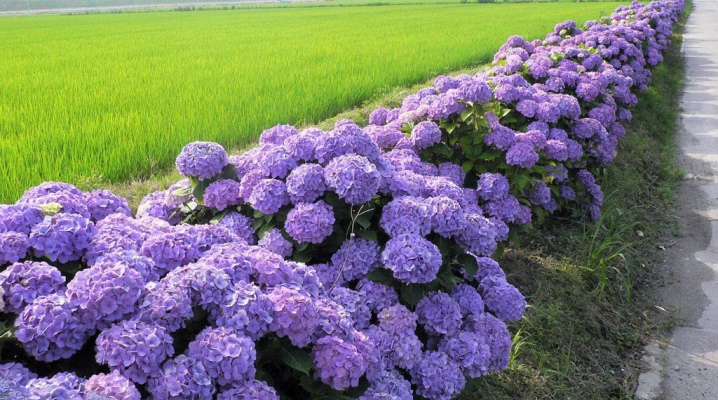
Garden hydrangea is a favorite of many gardeners. This is a beautifully beautiful flower, distinguished by airy buds-caps, lush inflorescences of different colors. It is hard not to notice such attractive plants in the garden. Hydrangeas can add a sophisticated touch to almost any landscape design. To successfully plant and grow these beautiful flowers in your garden, you need to know all the rules and nuances of these procedures.
Description
Hydrangea is a perennial flower with beautiful appearance. Since ancient times, it has been known among gardeners and has always been popular. If we translate the name of hydrangea from the Latin alphabet, then it means "a vessel with water." Plants are called that for a reason - hydrangeas love water. In Russia, the flower is found in the Far East, the Urals, in the northwestern part of the country, in the Moscow region.
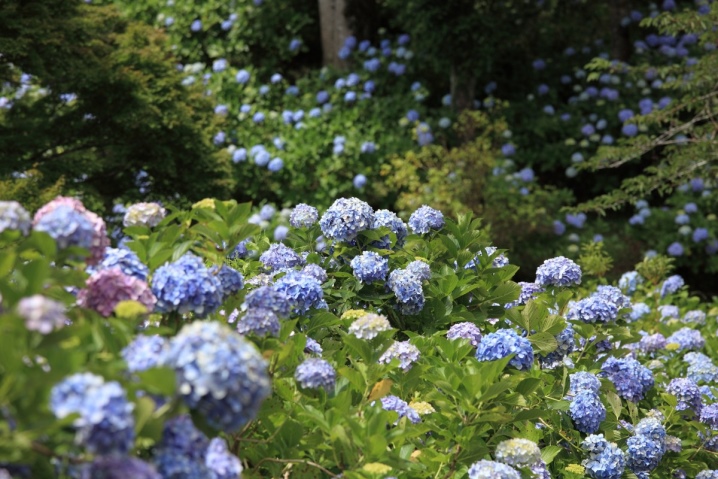
In cold climates, hydrangea cannot grow to the size that it can delight the inhabitants of southern Asia or Japan. Lush thickets of lianas intertwining in trees, as well as evergreen subspecies of this gorgeous shrub, will also not be able to please the eye. If we are talking about compact bushes, then, subject to proper care, they will look no worse than their large counterparts growing at home.
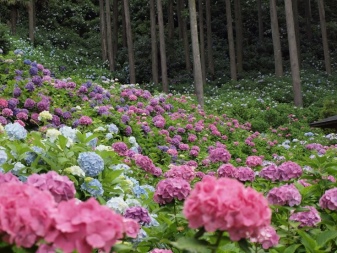

Hydrangea has large leaves. Veins are clearly visible on them. The edges of the foliage have denticles. The leaves are located on the plants opposite each other. The flowering period falls on the first days of summer. Flowering ends when frost sets in.
Hydrangea flowers are large, can be spherical or paniculate. The lion's share of the known varieties of the plant blooms with snow-white flowers.
However, large-leaved hydrangeas are able to change their original color depending on the level of acidity of the soil.
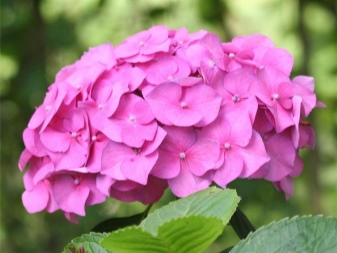
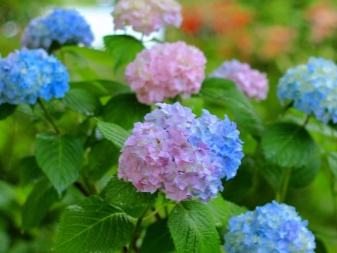
If hydrangea flowers bloom in white, then this indicates that the level of acidity of the soil is neutral. If, instead of white, there is a lilac or pink color, then this indicates an alkaline soil. When the ground is acidic, the flowers turn blue. The color of an attractive plant is influenced not only by the type of soil, but also by the aluminum content in it. Flowers can absorb this component.
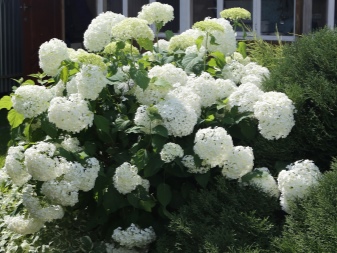
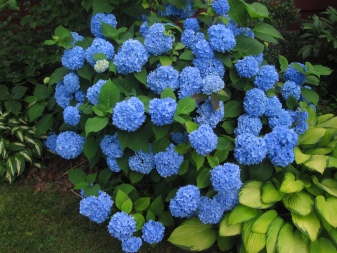
Hydrangea has a lot in common with another plant - the schizophragm. Otherwise, it is also called radicular hydrangea.
But do not forget that in reality this plant is not a hydrangea and belongs to a completely different genus, so you should not confuse it.

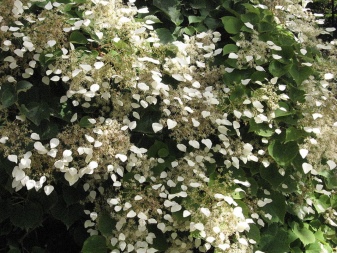
Overview of species and varieties
The genus includes more than 50 species of this plant. Let's take a closer look at the most common and popular examples of hydrangea.
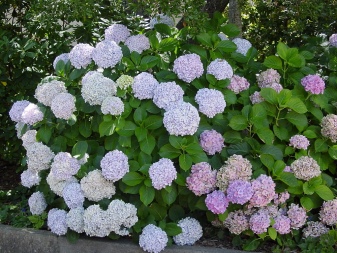
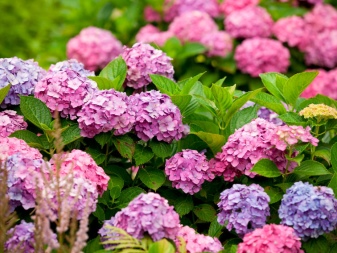
- Large-leaved. A shrub that, in comfortable conditions, can reach a height of 4 m. The flowers of such a hydrangea are collected in beautiful shields, the diameter of which is from 10 to 15 cm. The flowers are pink or white, sterile. Their usual diameter is 3 cm.
A spectacular ornamental plant that is perfect for growing not only in gardens, but also in parks. Differs in abundant flowering and an interesting bush shape.
It is often used as a houseplant growing in a pot.

- Paniculata. This flower is loved by many gardeners for its chic appearance. Inflorescences of panicle hydrangea are splendid, flowers can be pink, blue or snow-white. This type of hydrangea tolerates cold climates much more easily. It can be up to 2 m in height.
The leaves are distinguished by an oblong structure, the bottom of the plant has pubescence in the form of a soft pile. It blooms with large flowers (diameter 15 cm), which have white, cream or purplish red color.

- Tree-like. A spectacular ornamental shrub, the height of which can be from 1 to 2 m. It has a rounded structure formed by thin shoots covered with a light downy. The foliage has an ovoid shape and is colored bright green. The inflorescences are large, reaching 15 cm. They are characterized by the shape of the scutellum and are collected from snow-white flowers.
The species is known for good frost resistance, active growth after the winter season, and a high percentage of rooting of cuttings.
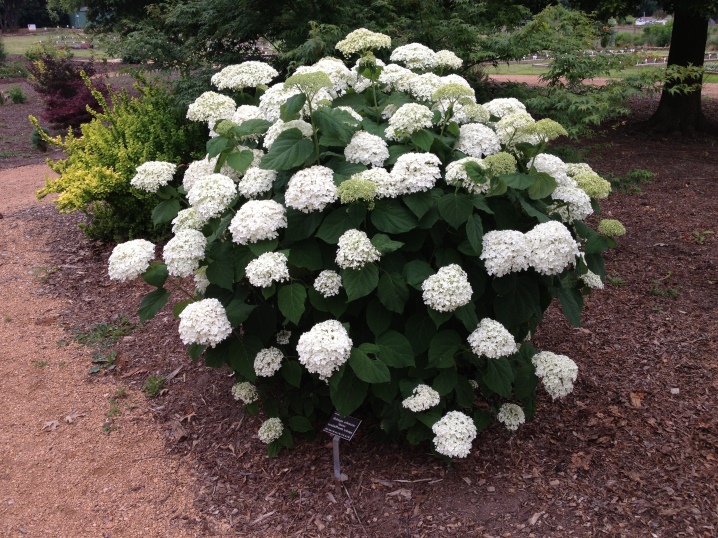
- Pereshkovaya. Another popular type of hydrangea. It is considered unusual as it exudes an interesting honey aroma. Although this plant is considered frost-hardy, while young, it must be covered to protect it from the cold.
In height, such a hydrangea can reach a mark of 10 m. This is an unpretentious plant that looks more like a liana.

- Oak-leaved. A perennial shrub from the hydrangea family. The average plant height is 2 m. The shoots are strong and tough, covered with wide leaves, which are very similar to oak leaves. They have a rich greenish tint.
The blooming period of the oak-leaved hydrangea is from June to September. The flowers are not very large and are combined into large panicle inflorescences.
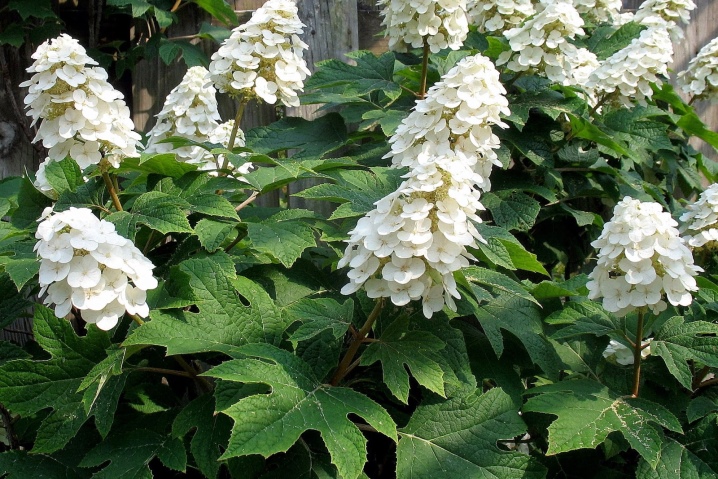
- Serrate or serrate-leaved. An attractive decorative appearance, which is characterized by flowers of not very large sizes. The serrated hydrangea is frost-resistant. It reaches a height of 100 to 120 cm. It has oval leaves.
An annual shoot of a green tint may darken over time. The inflorescences differ in the shape of the cap.
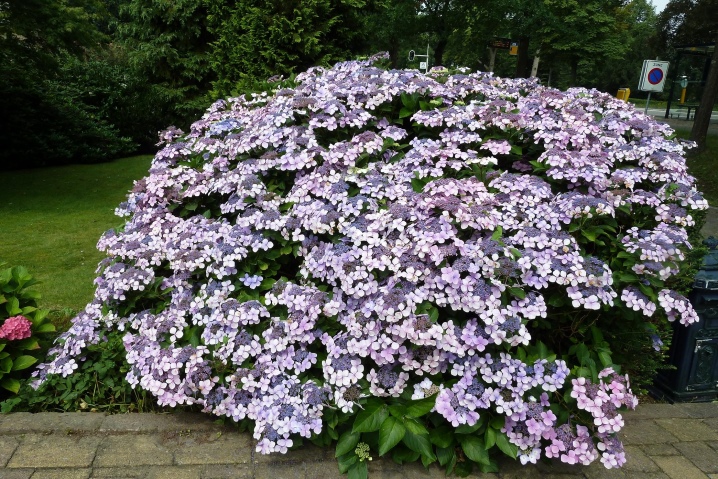
- Groundcover. Deciduous shrub, which can reach 3 m in height. The crown is wide-angle, the shoots have a characteristic brownish-red tint and a hairy surface. The foliage is ovoid.
Flowers are sterile, snow-white. Towards the end of summer, they acquire a purple or red color. They are collected in umbrella-shaped inflorescences, the diameter of which is 16 cm.
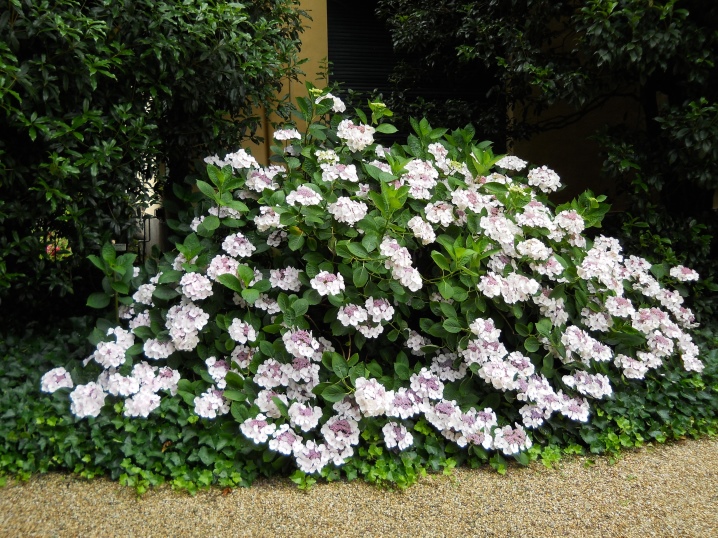
- Ash. A very beautiful shrub, the second name of which is gray hydrangea. It is a deciduous upright plant up to 2 m high. The crown is spreading, there are young pubescent shoots.
The leaves are wide, ovate, and have a pointed shape. Long and abundant flowering.
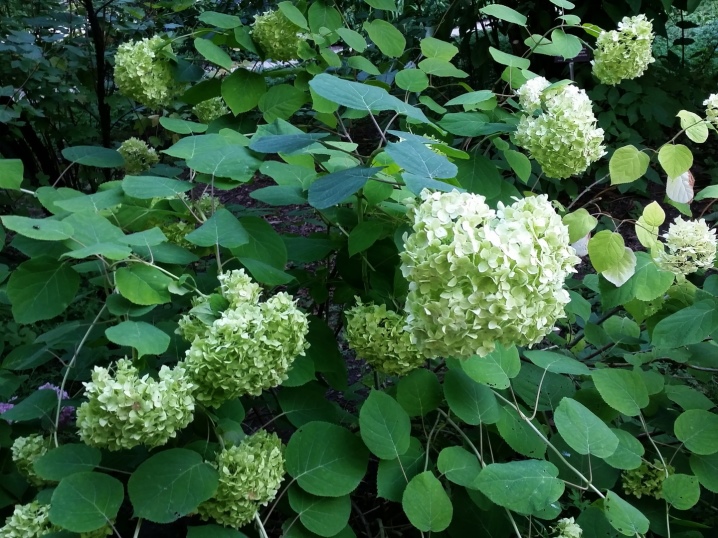
There are also many varieties designed to be grown in a garden. Let's take a closer look at the most famous varieties.
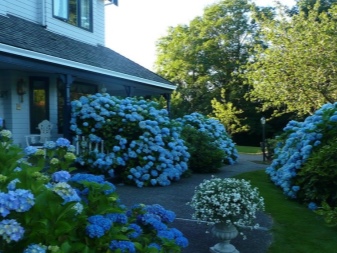
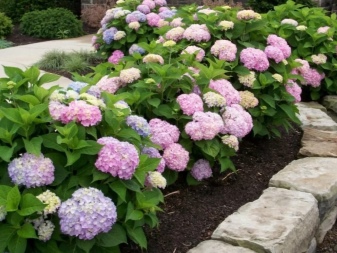
- Sibylla. Large-leaved variety. Differs in large flowers. The foliage is large and has a decorative appearance, a glossy surface. It is advisable to plant in sunny or partial shade.
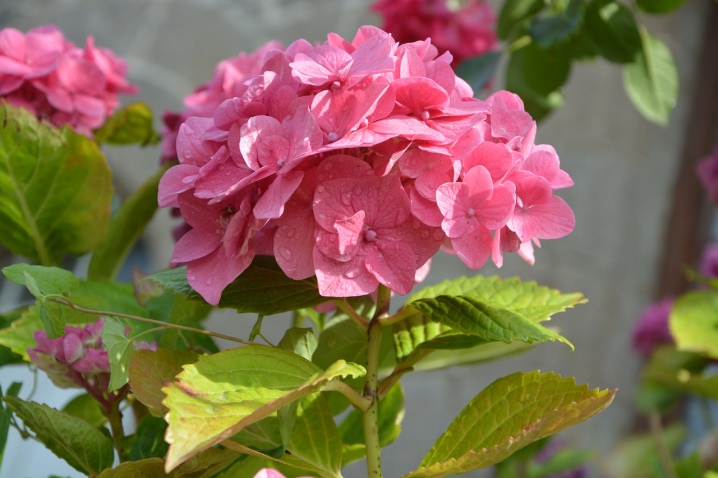
- Leichfeier. Also applies to large-leaved species. The flowers can have a bright pink color with a glossy surface. The leaves are rich green, shiny, elongated, have serrated edges. This plant is recommended to be planted in acidic or slightly acidic light soils with sufficient moisture.
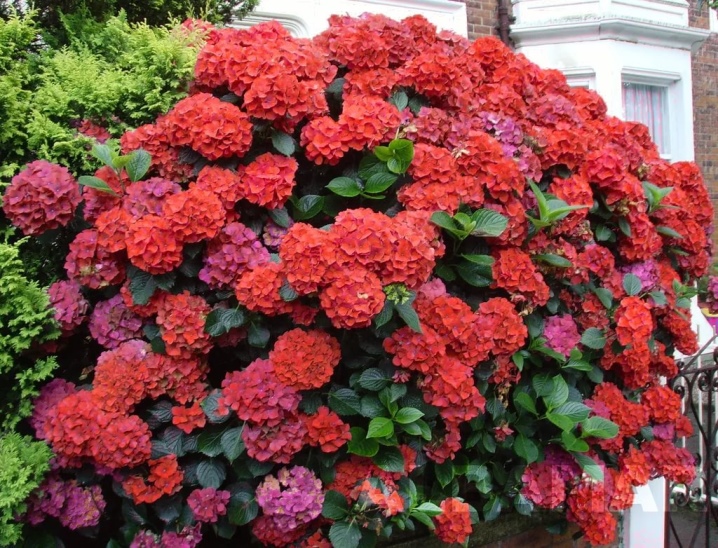
- "Bouquet rose". A gorgeous-looking hydrangea variety that, during its flowering period, forms a truly huge and lush bouquet, made up of a branched crown, completely covered with charming rounded inflorescences. The flowers are pink and blue. This plant is not suitable for planting in salty, alkaline or calcareous soil. It does not have high frost resistance.
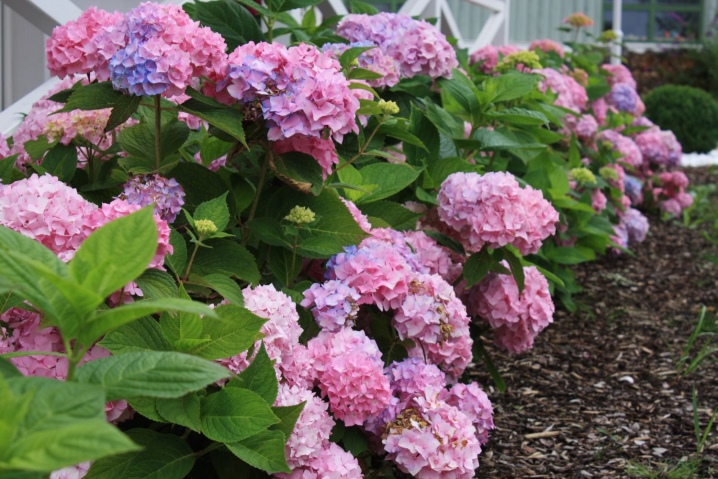
- Strong Annabelle. Derived from the tree hydrangea.Differs in white inflorescences blooming on strong and dense branches. Not afraid of rain or wind. The flowering period is June-September. This variety has been awarded several times at international competitions.
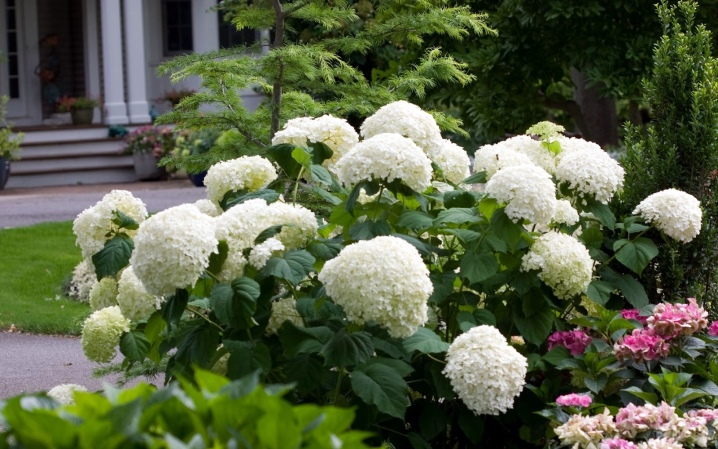
- "Grandiflora". This variety is famous for its spectacular appearance and long flowering. The inflorescences are splendid. They are colored and can change their color several times. The average height of the bush is usually about 2 m, and the width is almost 3 m.

- Invincibelle. The second name is Pink Annabelle. It is the first tree-like hydrangea to be pink in color. In addition to the interesting colors, it is also interesting because if, after the first flowering, the shrub is trimmed, it will bloom again after 6 weeks.
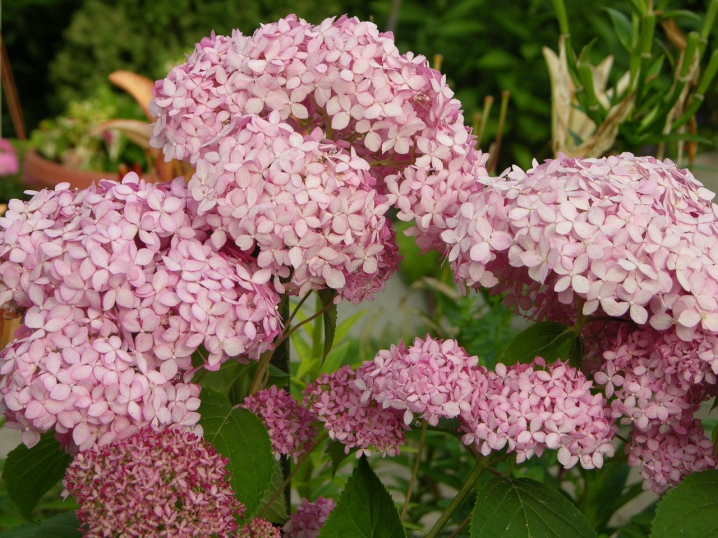
- Papillon. Panicle hydrangea, which is a straight bush. Its average height is 200 cm. The flowers have a beautiful white color. By the end of flowering, they are repainted in a pink shade.
They are collected in cone-shaped inflorescences, the length of which is 20 cm, and the diameter is 15 cm. The flowering is lush, rich. It is advisable to plant such plants in moderately moist soil.
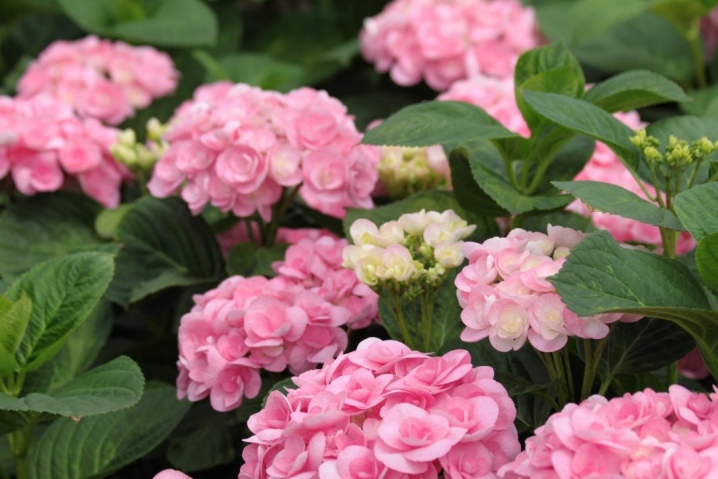
- Aisha. Another beautiful shrub with erect shoots. The foliage is dense. The average plant height is 1.5 m.
The flowers are large and spherical. Their diameter is 20-25 cm. The color of the inflorescences depends on the acidity of the soil in which the hydrangea grows.
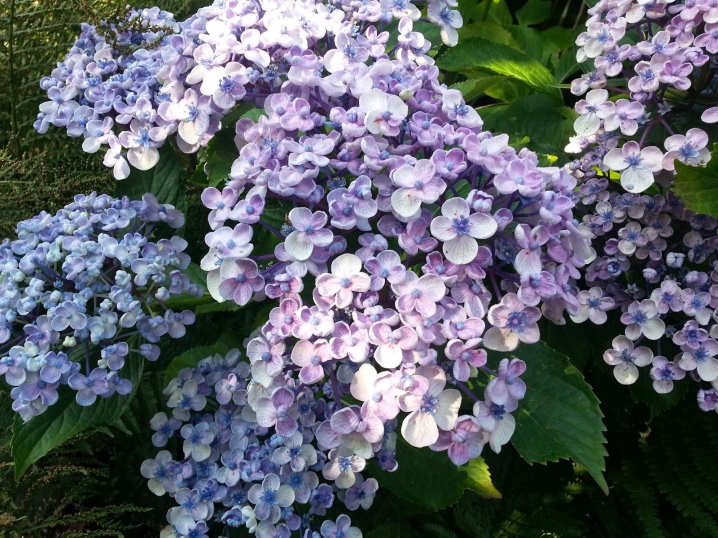
In addition to those listed, there are many more varieties of hydrangea that can be safely planted in the garden, for example:
- "Tricolor";
- "Nymphe";
- Magic Revolution;
- Mirai and many others.
Representatives of different varieties have their own characteristics and nuances of care, which are important for the gardener to keep in mind.
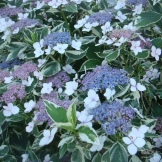
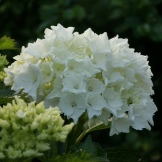
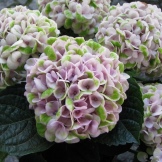
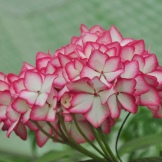
Site selection and soil requirements
It is necessary to carefully choose a place for planting a garden hydrangea. It is advisable to allocate for this plant an open area with sufficient sunlight. It will be great if the bush is illuminated for 6 hours a day, especially in the morning and evening. On hotter days, hydrangeas will need a little shading - the planting will grow well in ambient light conditions.
In semi-shaded areas, hydrangeas will also be comfortable, but they will bloom a little later and give fewer flowers. It must also be remembered that drafts can cause serious harm to this plant.
Hydrangea should not be planted under tall plants. Otherwise, such a neighborhood will leave it without the required amount of moisture.
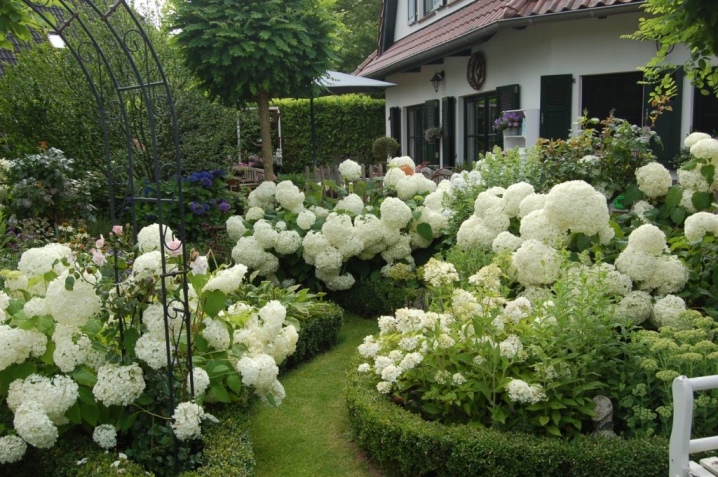
Garden hydrangea grows very well in loose and moisture-permeable soil with unhindered oxygen access. It is desirable that the land be enriched with humus. Compacted areas with clay, poor air permeability and long drying are recommended to be diluted using peat and humus. The optimal soil for garden hydrangeas is a combination of leafy soil, well-decomposed compost, peat and river coarse sand. The proportions should be like this: 2: 2: 1: 1.
Growers should remember that garden hydrangeas are very disliked by calcareous soils. Due to lime, plants begin to suffer from a serious ailment - chlorosis, which leads to yellowing of the foliage. The soil in which you plan to plant the hydrangea should be slightly acidic.
In this case, the color of the plant will be as bright and saturated as possible.

Landing features
The first step is to determine the timing of planting hydrangeas. These flowers are sold in pots and are planted from the spring season to late autumn. Low temperatures are not to the liking of all varieties, so it is not recommended to plant flowers in the late autumn period.
In our climate, hydrangeas run the risk of not having time to take root and take root in a new place, so they need to be planted only at the moment when they are at rest.It is recommended to resort to such procedures in the spring when the ground warms up (late April-early May).
If severe frosts are predicted, the plants must be covered.
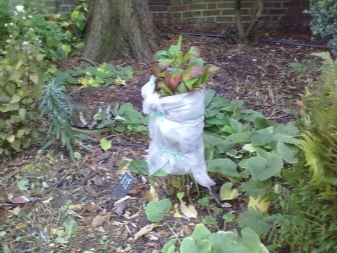
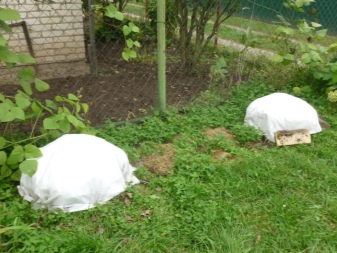
Having chosen a place for planting hydrangeas, it is necessary to properly prepare the soil.

Let's consider how to do this.
- First, the site must be freed from stones, any debris, weeds (especially strongly rooted ones).
- If the soil has an excessively high pH level (more than 6.5), you need to resort to acidification with peat or mulch. The pH should be between 4.5 and 5.5.
- Lightweight and highly permeable soils will need to be enriched with compost, rotted manure. The introduction of an organic component increases the water capacity of the substrate, saturates it with the necessary nutrients, and has a positive effect on the density level. In such conditions, the hydrangea root system will develop much easier and faster.
- Before replanting seedlings, it is worth adding a special hydrogel, fertilizers and special substances to the ground, which will improve the structure and condition of the soil as a whole. The hydrogel will help increase the water capacity of the soil, due to which it will stay hydrated longer - the plant will not be subject to destructive drying out.
- If the soil is heavy or over-compacted, then the preparatory measures will have to be carried out at least a year before the transplant. To lighten the substrate, it is mixed with a 10 cm layer of pine bark, peat, gravel or compost. In the fall, you need to dig up the soil 20-30 cm deep.
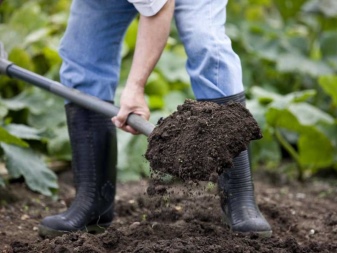

The landing technique itself involves the following steps.
- Gotta dig a hole, the depth of which will be similar to the depth of the flowerpot, but the diameter should be 2 times larger. Most often, hydrangea is planted in pits with a diameter of 60-70 cm and a depth of 40-50 cm.
- It is necessary to add a small layer of manure or compost, acidic humus, garden soil. All components should be added in a 1: 1: 2 ratio and mixed. If the soil is heavy, then a 10-12 cm drainage layer is poured onto the bottom of the pit (from coarse gravel, small pebbles, vermiculite).
- The seedling and the pot are immersed in a tank of water. As soon as the soil gets wet, the plant is carefully taken out. The root ball should not crumble. Excessively lengthened or damaged roots should be cut off.
- The flowers are planted to the depth at which they grew in the container. If the soil is loose or sandy, then in this case you need to plant 3-4 cm deeper.
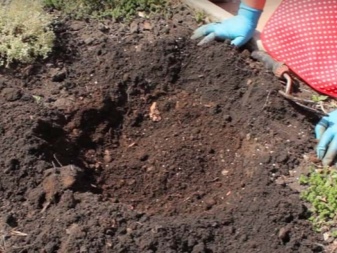
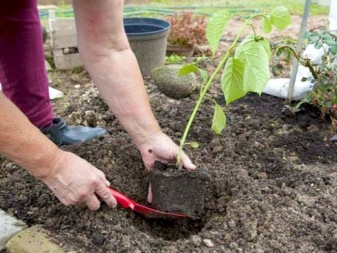
Care rules
It is not enough to properly plant hydrangea seedlings in the open field. It is equally important to properly care for them in the future, given what this flower loves and what does not tolerate.
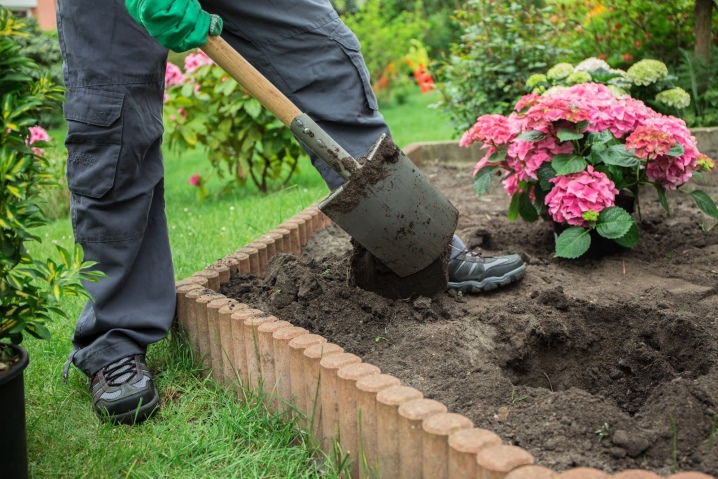
Watering
Ornamental garden shrubs are characterized by a large volume of green mass, so they need a constant replenishment of moisture reserves. Lack of liquid can lead to the fact that the foliage of the hydrangea begins to wither in the hot summer, the intensity of flowering will noticeably decrease, the plant will weaken greatly.
During periods of summer heat, the flower should be watered regularly and intensively, at least 2 times a day. The water should not be hard.
Too much calcium and magnesium can harm hydrangeas.

Pruning
Hydrangea pruning must be done 3 times - in spring, summer and autumn.
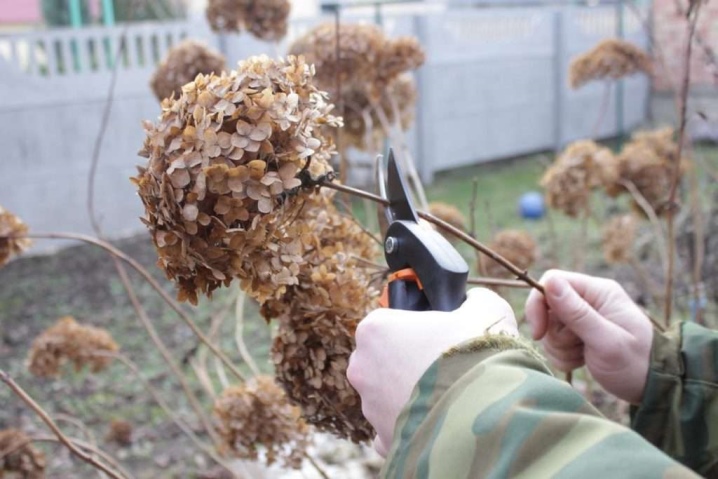
- Spring. The large-leaved garden hydrangea, unlike the paniculate and petiolate varieties, can tie flower buds in the fall - this species blooms on last year's shoots, therefore, with the onset of spring, only frozen elements of the shoots should be removed, but not completely. This is due to the fact that the kidneys can be located in their lower part.
- Summer. Cut off all inflorescences that have already bloomed, at a height of 10 cm above the base or slightly above the first upper leaves.
- Autumn. Pruning should be more intense during this period. It is necessary to leave annual shoots with fully developed buds. You should cut off young and thin shoots, the buds of which are poorly expressed.It is also necessary to remove thin shoots or branches that are not well developed from two-year-old branches.
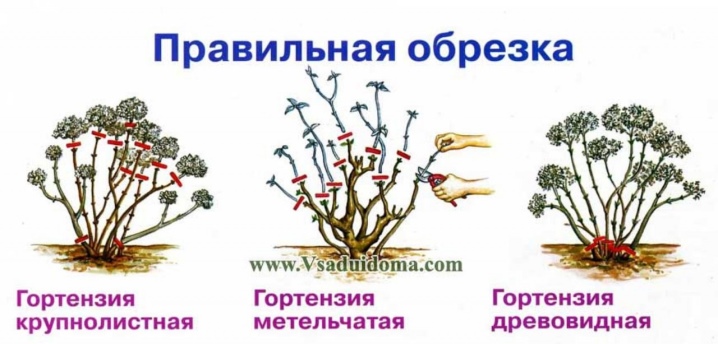
Top dressing
The cultivation of garden hydrangeas requires the use of suitable fertilizers to promote plant growth and strong immunity. This flower has special requirements for feeding. The latter should be a combination of the following necessary components:
- ammonium sulfate;
- potassium sulfate;
- superphosphate.
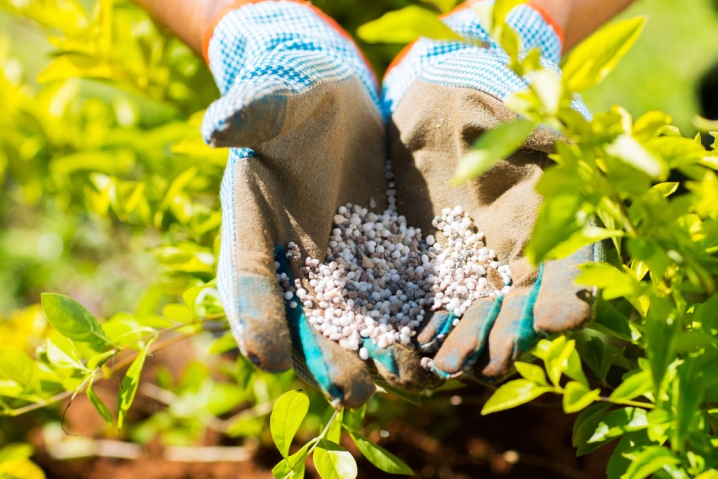
During rapid growth, shrubs need to be fed every 10-14 days. In the last days of July, for the good development of flower buds, specialized fertilizers are added, suitable for hydrangeas, in which components such as potassium and phosphorus predominate.
Top dressing of a natural type is not used very often. The manure that is brought under the bush must necessarily be fully rotted, since the hydrangea does not tolerate fresh fertilizers (especially horse manure). On sale you can find a large number of special multicomponent fertilizers produced for these ornamental plants. They can be produced in both dry and liquid form.
The following options are popular:
- Florovit;
- "Substral".
You can also feed your garden hydrangeas with natural fermented manure.
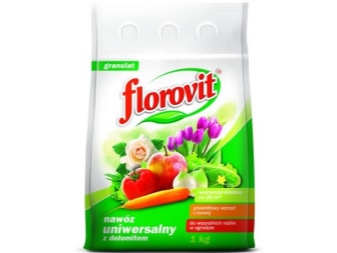

How does it multiply?
Reproduction of hydrangeas carried out in 3 main ways:
- seeds;
- cuttings;
- dividing the bush.
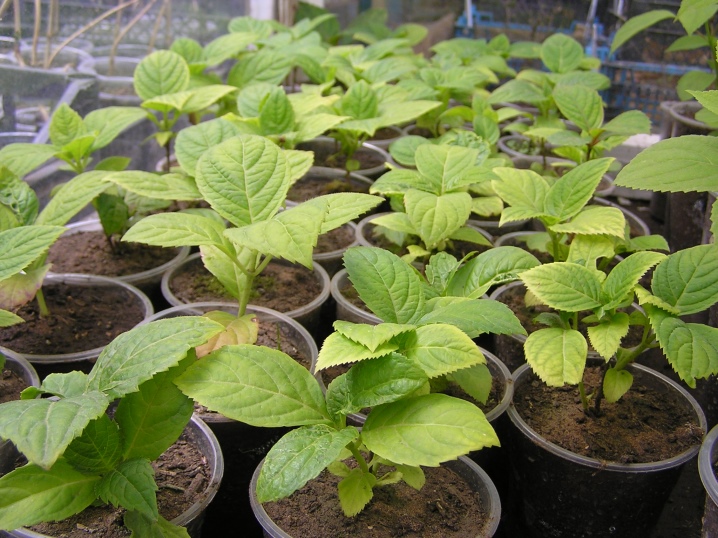
This flower can be bred independently at home. In the first method, the seeds must be sown on the surface of the heated fertile soil without prior embedding. Using a spray bottle, irrigate the seeds and sprinkle them a little with sand. This is usually done in May. Sprouts can be expected after 3-4 weeks.
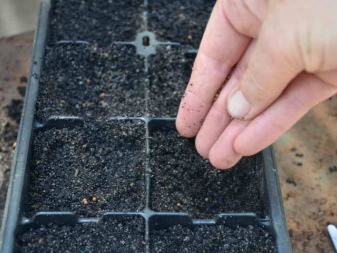
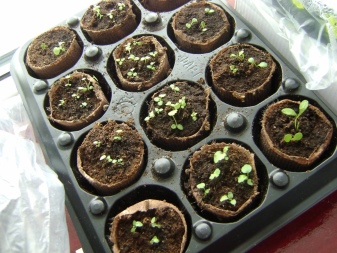
Hydrangea can be planted with cuttings. For this, the upper part of the lateral shoot with 2-3 pairs of leaves is cut from the bush. After removing the lower leaves, below the knot you need to make a cut at an angle of 45 degrees. It is treated with an agent that stimulates plant growth. The top cut should be left straight and the remaining leaves should be shortened by 50%.

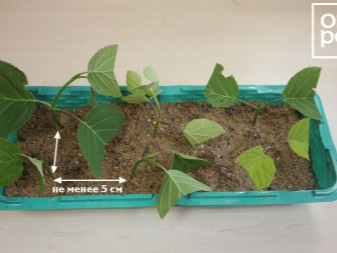
Then the cuttings must be rooted in separate tanks in a suitable soil. The distance between them should be at least 5 cm. The seedlings should be sprayed with a spray bottle and then covered with foil. Planting will need to be placed in a shaded place with a temperature of 20-25 degrees during the day and 15-18 degrees at night. When the overgrown roots have reached 2 cm, the plants can be moved to separate pots.
In winter, it is better to put them in the basement, dig them into the ground.
In the spring, with the first hints of growth, it is necessary to start watering the plantings, gradually warming them up in the sun. After that, they can be transplanted to a permanent place.
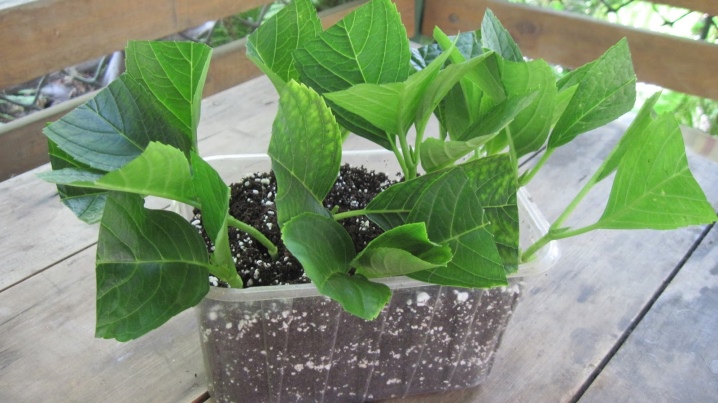
Reproduction by dividing the bush is best done in the spring. The dug out mother plant is carefully divided into small pieces, making sure that each of them has a growth bud. The roots are made a little shorter along with the shoots, and then they are planted so that there is a distance of 1 m between them.It is better to make a hole for bushes with a diameter of 50-60 cm.

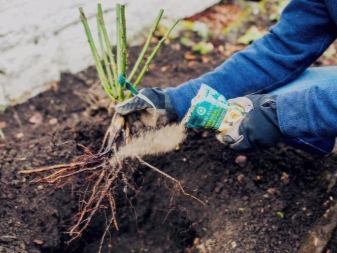
Diseases and pests
Consider what common diseases and pests are dangerous for hydrangeas.
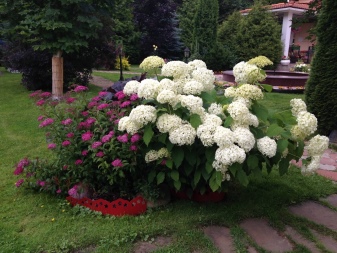
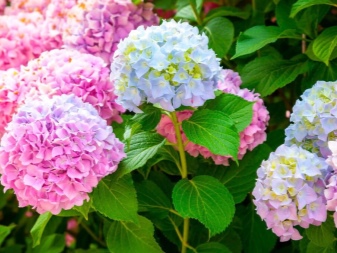
- Chlorosis. May occur if the flower grows in high pH soil. It manifests itself in the form of yellowing or lightening of foliage. It is necessary to use acidifying fertilizers or fertilizers with a low calcium content.
- Sunburn. In too hot weather, the leaves of the flower may turn brown or yellow. To avoid such problems, the plant must be provided with shade and regular watering.
- Gray mold. Appears if the plant overwintered incorrectly or there was abundant, frequent precipitation. The disease leads to rotting of both buds and flowers. The infected areas must be removed. Use fungicides such as Topsin V500 CS or Captan.
- Powdery mildew. The disease first manifests itself pointwise, but then plaque can cover the entire leaf plate. The apical shoots are deformed.Infected elements must be removed, use fungicides for spraying. Sulfur preparations are suitable.
- Aphid. Appears at the ends of shoots and on the lower part of foliage. The parasite sucks the juices out of the flower. You can get rid of aphids with insecticides, for example, "Pirimor" or "Provado".
- Spider mite. It sucks juice from foliage, appears from May to August. The best remedy for fighting this parasite is Karate 050 CS.

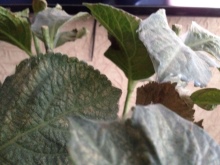
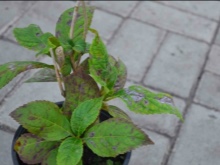
Possible problems
Hydrangeas are subject to a number of problems that need to be addressed.
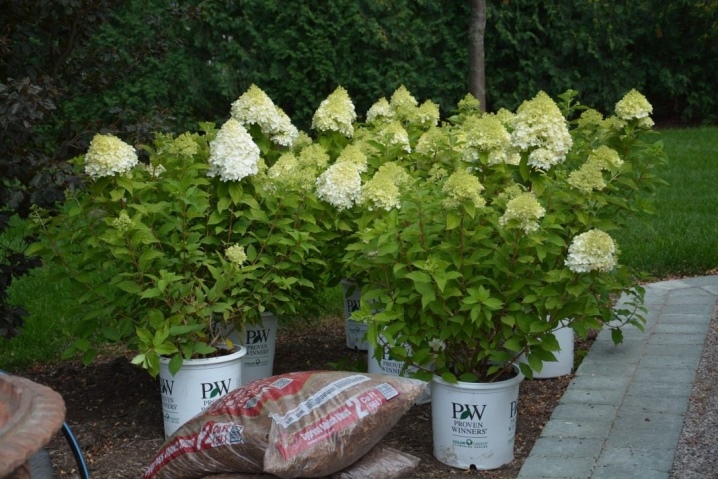
- Light leaves. Blanching of foliage can be the result of alkaline soil, lack of minerals, or damage by pathogenic bacteria. Most often, this problem occurs due to the poor quality of the soil. The pH must be kept between 4.0 and 6.5. If parasites or chlorosis have become the cause of the lightening of the foliage, then the treatment will consist in the use of high-quality dressings or insecticides.
- Poor growth. Sometimes gardeners complain that hydrangea grows poorly on their plots. There can be a lot of reasons for this - from poor wintering of a flower to a damaged root system. There may be a lack of oxygen or fertilizers, the acidity level of the soil may be lowered. Such an ailment occurs due to drying out of the soil, improper pruning. It is better to look for the cause of the trouble that has arisen in the spring, when the growth phase is active.
- Leaves dry. Hydrangea foliage may dry out if the soil is too dry, a careless transplant was carried out, the soil is too wet, the air humidity is too low. This problem arises due to drafts, in conditions of excessively dense and heavy soil.
- Leaves turn yellow or black. If black or yellow spots appear on the leaves, this may indicate watering with too hard water. Such consequences are caused by a low level of acidity of the earth, too much sunlight. Care should be taken to ensure that all the necessary trace elements are present in the soil so that this problem does not arise.
- The flower withers. This ailment can manifest itself for the following reasons: lack of regular watering, lack of lighting, lack of top dressing in the ground, poor wintering, damage to the roots, water fell on the leaves during watering, chlorosis.

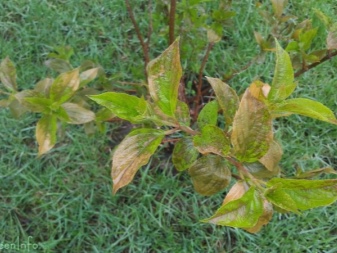
Application in landscape design
Hydrangea can be a decoration for any garden area.
Can combine flowers of different colors and plant them around the house, steps.
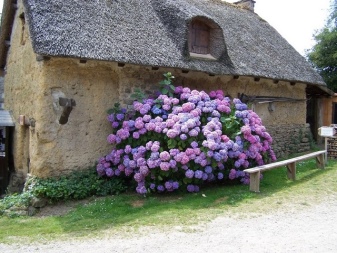
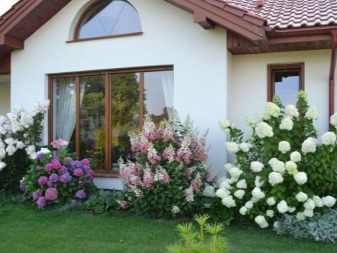
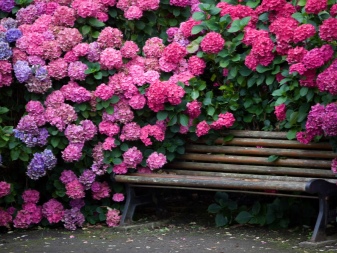
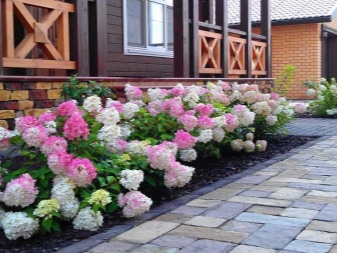
Whole shrubs are made from lush hedges.
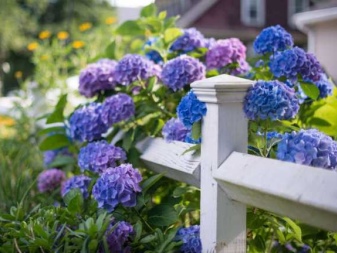


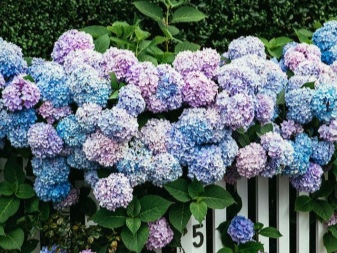
Gazebos look gorgeous, complemented by tall and solid bushes planted near them with a large number of inflorescences.
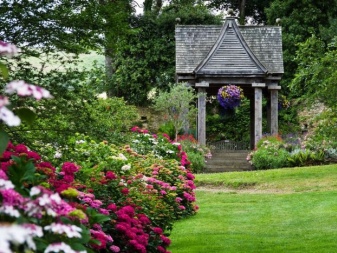
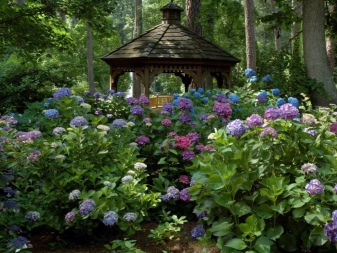
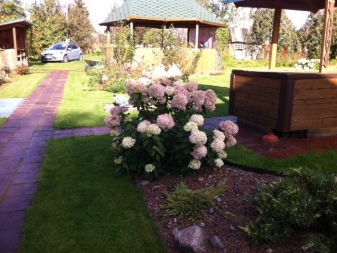

It will be possible to decorate the landscape with rich "bouquets" of purple and blue flowers. They can be planted along the paths on the site.
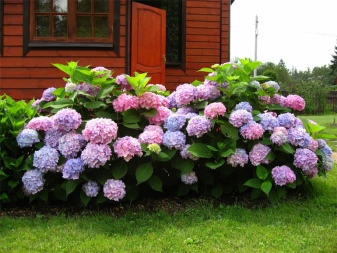
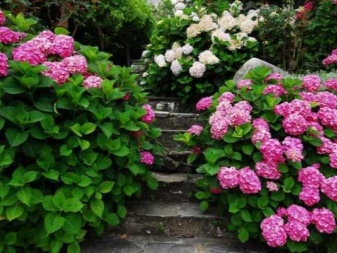
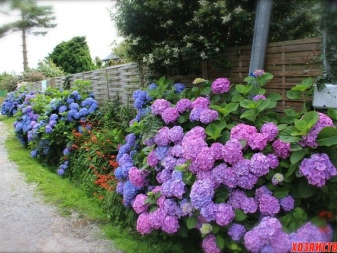
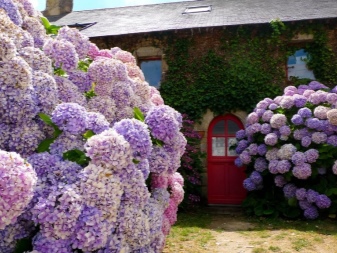
The following video will tell you more about planting and caring for a garden hydrangea.



































































The comment was sent successfully.